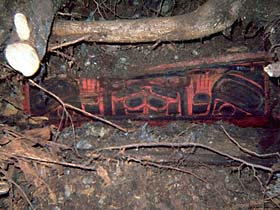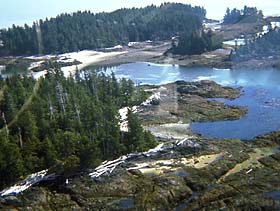|
(Page 2 of 2) |
The first archaeological excavation on Haida Gwaii was that of a shell midden near Masset, conducted in 1919 by Harlan I. Smith of the Canadian Museum of Civilization. He was following up on his earlier work with the Jesup North Pacific Expedition headed by anthropologist Franz Boas. Smith had served as a photographer on that expedition, taking thousands of photographs of coastal villages from Washington State to Alaska. Unfortunately, his wonderful plates do not include Haida Gwaii villages. Another member of the Jesup Expedition, John R. Swanton, the principal ethnographer of the Haida, did do work at Masset and Skidegate, and Smith may have been influenced by the expedition connection with him to undertake archaeological work near Masset. Since precise techniques like radio-carbon dating were not then available, Smith greatly underestimated the maximum age of the shell middens on Haida Gwaii and in the Prince Rupert area on the mainland where he also dug.

My own archaeological work on Haida Gwaii was an offshoot of excavations in Prince Rupert harbour that began in 1966. Then in 1968, Wilson Duff of the Royal British Columbia Museum encouraged me to investigate observations he had made on Graham Island of shell middens on raised terraces that marked ancient strandlines from times of higher sea levels. The brief excavations I conducted there at Honna River yielded dates in the 3,000 to 4,000 year range and much evidence of burials and utensils roughly equivalent to those of similar date from the Prince Rupert harbour sequence.
That same year, we discovered another midden at Blue Jackets Creek on Masset Inlet on the north coast of Graham Island, which Patricia Severs later excavated. The artifacts from 3,000 to 5,000 years ago were strikingly different from those found in the Prince Rupert area, but those from about 2,000 years ago showed strong influences from the adjacent mainland. This indicates the beginning of a trading pattern among the Haida and the neighbouring Tsimshian and Tlingit that led to increased sharing of symbols of wealth and materials of exchange, and eventually to closely parallel art styles that were different from those of groups to the south.

Although many water-logged archaeological sites on Haida Gwaii contain wood objects that would document fully the development of Haida art styles, none has been excavated. The excavation of such sites would be very productive, as was demonstrated in water-logged sites several thousand years old in Prince Rupert harbour, from which decorated wooden bowls, boxes, canoe paddles, etc. were successfully recovered and their artistic qualities preserved, using specialized techniques. And few shell midden sites on Haida Gwaii have been excavated, compared to the mainland, partly due to more expensive and difficult logistics of mounting archaeological expeditions there, but also because the Haida themselves have not encouraged such work. All of the old village sites and shell middens contain numerous skeletons, a reminder of "the great dying" that carried off most of their population in the last century. This has made the Haida particularly aware of the near-impossibility of conducting archaeological research without disturbing many such burials.
|